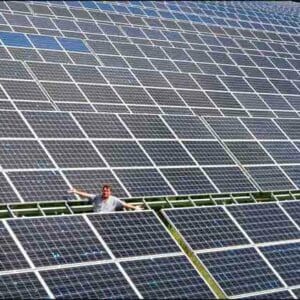You may have heard that Eco Sustainable Solutions currently runs the largest solar farm in the UK. At over 380 acres, it generates over 70MW of energy and powers more than 27,000 homes in the local area of Bournemouth at its peak. The solar farm is so large, in fact, that it requires 6 separate connections to the national grid to prevent it from overloading the connection. You can find out more about our solar farm in our infographic here.
Solar farms, as I’m sure you’re aware, rely on the sun. So it begs the question, why would we bother to build a solar farm in a country that only sees the sun for, on average, 17% of the year!?
Firstly, solar panels are not as expensive as they once were. In 1977, solar panels cost $76.67/watt (dollars per watt), but in 2013 that cost fell to $0.7/watt. In 1977, our 70MW solar farm would have had a theoretical cost upwards of $5.7billion.
In April 2010, the government announced and put into action a scheme that lowered the cost of solar panels even further. The Feed-in tariff would pay companies and households 41.3p per kWh they produced, further incentivising people to put their trust (and money) in solar.
These two changes to the UK’s energy production cause the UKs production from photovoltaic solar to rocket upward. At the start of 2010 the UK was producing 95MW of energy from solar energy, this leaped to 9000MW at the end of 2015. This tremendous drop in the cost of solar has resulted in a huge uptake in the production of solar. As of 2016, Eco Sustainable Solutions alone produces 3 times more energy from solar than the whole of the UK was producing 7 years ago.
But how does 380 acres of solar farm produce 70MW of power when it’s only sunny 17% of the time? Luckily for us, photovoltaic solar cells don’t actually need direct sunlight to work. In fact, some solar solutions work better when it’s not sunny. The hotter solar cells get, the less efficient they are, so by using a solar panel that reach peak efficiency during the less sunny times, Eco can reap the solar benefits for the other 87% of the year.
Because of these efficiencies, Eco’s solar farm produces 0.184MW of energy per acre. Compare this to Solar Star (the world’s largest solar farm, California) that produces 0.180MW/acre, the little-solar-farm-that-could is actually more efficient at producing energy than the world’s largest, despite its location.
